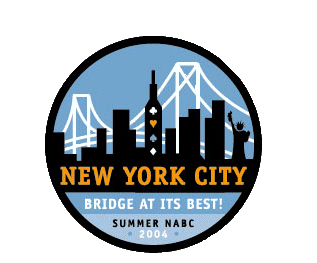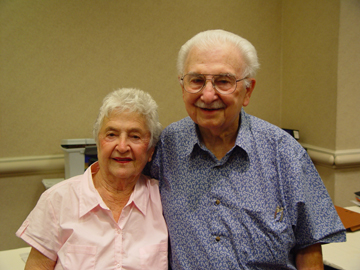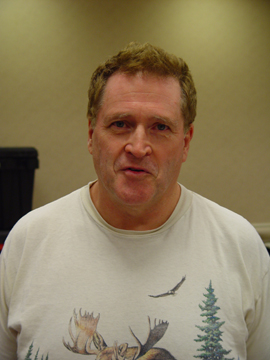
Bridge At Its Best ....
Page 1 |
Lampert’s love affair still going strong
Adele & Harry Lampert By Lynn Berg How many 87-year-olds will present themselves to the partnership desk to play a two-session game at this tournament? Harry Lampert will. Lampert loves the game. He started playing bridge in the Thirties, mainly with older brother Bernard, a National Collegiate Par Tournament winner playing at Cornell while on the G.I. Bill. Lampert had joined ACBL before he went into the Army in 1942, but had little time for bridge. Making a living first in animation, then in public relations and as a print cartoonist, Lampert developed a comic book figure, “The Flash,” which is still popular with comic book devotees. He always played some bridge, often with Bernard (who became a New York lawyer and arbitrage specialist), and he began in the mid-Seventies to look forward to retirement in 1975 and playing more bridge. Bernard led the way, making Life Master in the Fifties. More than just playing, though, Lampert wanted to teach bridge. He had become a cartooning teacher while still active in the advertising agency he built, and he applied the same energy and zest to this new project. Lampert began teaching bridge in 1976, becoming a Life Master that year. The other“credential” he thought essential to being credible as a bridge teacher was to be an accredited teacher, so he joined the American Bridge Teachers Association that year. Best known today to many bridge players He first published the books himself because, as he puts it, “No sane publisher would take a book of cartoons for teaching bridge.” Using his knowledge of the publishing business from his advertising days, he and his wife, Adele, produced and promoted his books. He has sold nearly half a million bridge books, and all of his books are still in print — now published by Baron Barclay. Lampert is also a regular at comic book conventions, enjoying the changes in that craft, too. Lampert and Adele, married 61 years, still play bridge together two evenings a week. On Saturday morning, he went down to the partnership desk looking for someone who has the energy to keep up with him and enjoy the game. |
Computer battle under way todayThe ACBL established an official World Computer Bridge Championship in 1996 that has run annually ever since at a major bridge activity. This year’s championship is being held in Concourse H here in the Hilton starting today. Kibitzers are welcome. The top bridge-playing programs, or robots, from around the world are competing. Can JACK (the Netherlands) retain its three-year reign as champion? Will last year’s runner-up, Bridge Baron (USA) take over the top spot? The 2002 finalist, Wbridge (France), the 2001 finalist, Microbridge (Japan), the 2000 champion, Meadowlark Bridge (USA), the 2000 finalist, Q-Plus Bridge (Germany) also will be in strong contention. There are other contenders as well – Blue Chip Bridge (United Kingdom) and Sabrina (France) are possibilities. The format is a round-robin team event with the top four robots advancing to a semifinal knockout match. For information as well as the history of this championship, go to Computer Championships or e-mail Al Levy. Two Top 10,000
 Walter Fontaine and Dick Benson Stories on page 2 History of the SpingoldThe Spingold Master Knockout Teams, first known as the Challenge Knockout Teams, was contested for the Asbury Park Trophy in the early days. The runner-up team in the regularly-scheduled portion of the event had the right to challenge the winners to a playoff. This right was never utilized. In 1934, 1936 and 1937, the Masters Teams-of-Four and the Asbury Park Trophy were separate events, providing two sets of winners. In 1938 the event became the Spingold Master Knockout Teams. At one time, the Spingold was a double elimination event, usually lasting nine or 10 sessions. It was scored by International Match Points and was restricted to players with 100 or more masterpoints. In 1965, the double elimination method was replaced by three qualifying sessions (subsequently reduced to two), followed by single elimination knockout matches. The preliminary qualifying session was dropped in 1970. The Spingold Trophy, donated by Nathan B. Spingold in 1934; the Vanderbilt Trophy, awarded to the winners of the Vanderbilt Knockout Teams at the Spring NABC, and the Reisinger Memorial Trophy, donated by the Greater New York Bridge Association in memory of Curt H. Reisinger and awarded to the winners of the Reisinger Board-a-Match Teams, are ACBL’s most highly prized team trophies. 6079 Tables
|
67 foreign stars still in SpingoldAll the top seeds advanced in the Spingold Knockouts yesterday and will lead the way into today’s Round of 64. An interesting point – 67 of the players still in the event are foreigners, with England leading the way with 15 players. Surprisingly, India is next with 10. Other countries: Poland 9, Italy 8, Norway 7, Sweden 5, Bulgaria 3, Israel 3, Turkey 2, Egypt 2, Australia 1, France 1, Japan 1. Kennedy upset in Wagar KnockoutAll but one of the top seeds in the Wagar Knockout Teams advanced to the second day. The lone casualty was the No. 4-seeded squad captained by Betty Ann Kennedy, eliminated with two losses in a four-way match. Kennedy, of Shreveport LA, was playing with Linda Lewis, Las Vegas; Lisa Berkowitz, Old Tappan NJ; Joann Glasson, Pennington NJ; Margie Gwozdzinsky and Susan Wexler of New York City. They lost in the first match to a team captained by Ellen Cherniavsky of Silver Spring MD (Barbara Ames and Diane Walker, Gaithersburg MD, and Rae Dethlefsen, Reston VA). In the second match, against the other loser from the morning session, Kennedy fell to the team led by Nadine Wood, Silver Spring (Terry Michaels, Prairie Village KS; Laurie Kranyak, Bay Village OH, and Linda McGarry, Stuart FL). The top-seeded team, led by Lynn Baker, sat out the first day of play, but joins the field as the round of 16 begins today. New Life MastersLydia Herman became a Life Master the old-fashioned way – in a pair event. She and Susan Weiss played together in the Sunday Open Pairs, and Herman got more than double the number of golds she needed to go over the top. It was the great moment of a lifetime for Beth Gleick of New York City. She needed 13 golds when she came to the tournament. She got 12 last Friday, then added 1.7 yesterday in a knockout event. Her partner was Barbara Weinstein of New York, and their teammates were Hope Byer and Linda Morse of New York. Early start means more time to eatCompetitors in the Spingold and the Wagar Knockouts had a brand new experience – they didn’t have to wolf down their dinners so they could be back at the table on time. The new starting times made this possible. With the second half of each match starting at 4 p.m. instead of 8 p.m, most matches were over by 9 p.m., and the rest of the evening was theirs. Were the players on time for the early 10 a.m. start yesterday? Yes – nobody was late. Were the players unhappy because they had to get up a few hours earlier than usual? According to Tournament Director Guillermo Poplawsky, who sold the entries, he received only one sarcastic complaint. World championship team matches have been using the early times for many years now, and they have proved popular. Bob Hamman, who has played in many a world championship, thinks it would be a good idea to start at 9:30 instead of 10. And he would shorten the time between sessions. “It’s good to be getting through early, but it would be even better if we could get through another hour earlier. |


 New York 2004 passed the 6000-table mark yesterday. Total attendance to date is 6079 tables.
New York 2004 passed the 6000-table mark yesterday. Total attendance to date is 6079 tables.